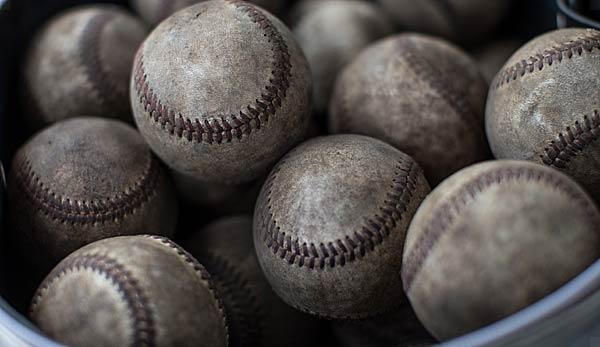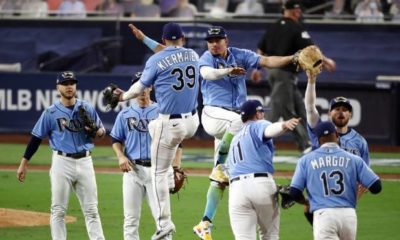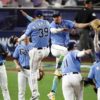MLB
MLB: Was the homerun explosion planned?
The MLB has set a sensational homerun record this season.The old record was already reached on 19.The European football team surpassed its best performance since the end of September, at a time when 168 games were still outstanding.It’s a spectacle for the fans, the players are amazed and disappointed.How did the record come about?
This season Giancarlo Stanton, J. D., will be back this season.Martinez and Co.around 40 percent more home runs than three years ago.The year 2014 was still called the “Year of the Pitcher”, this year is definitely marked by the Big Hitter.
The increase in the number of homeruns spans the entire league and can’t be explained simply by the fact that some stars or rookies like Aaron Judge had a good year.
On the other side of the ball, pitcher like Jake Arrieta wonders,”I’m getting my balls kicked out, I haven’t seen anything like that until this year!”
Experts have also been looking for the reasons for the increase in homeruns for some time now and often come to the same simple reason for development: baseball.
“I understand that people like conspiracy theories,”said League Commissioner Rob Manfred, referring to the homerun record,”but I wish I was smart and effective enough to make such a change.”
Manfred and the league are accused of intentionally changing the balls to make the game more spectacular and thus generate higher ratings.
Baseball expert Ben Lindbergh and Sabermetrician Mitchel Lichtman are trying hardest to prove it.In a widely acclaimed study published by The Ringer, they conducted innovative tests on the playground equipment to explain current developments.
The two first auctioned 36 balls used in the MLB on eBay, 26 of which were purchased between May 2014 and September 2015, while the remaining ten balls were played from May to July 2016.
At the Sports Science Center at Washington State University, they tested baseballs for intuitive dimensions such as size and weight, but also for smaller details such as the height of protruding seams.
These are created by a wax-coated thread over two metres in length, which holds the two pieces of cowhide together on the top layer of a baseball.The surface created by this long thread slows down the ball as it flies through the stadium.
They also tested the restitution coefficients, a measure of the ball’s rebound.They shot the balls with exactly 120 miles per hour into a steel cylinder and watched the jump-off height.The higher the ball bounced off, the farther it would fly through a ball park.
The results of the study are clear: the “younger” balls were all smaller and thus lighter, had shorter seams and jumped off higher.
In a further step, the two scientists used computer software that allowed them to simulate the trajectories of baseballs with different characteristics.
In comparison to the older balls, the 2016 playground equipment flew an average of just over two metres further on.Baseball physicist Alan Nathan calculated:”If all balls are hit by this distance on average, the number of home runs would increase by 25 percent.
Since such balls make the game much more appealing in terms of possible home runs, the MLB scene is called “Juicy Balls”.
Detroit Tigers pitcher Justin Verlander has also read the study and sees his perception of the field confirmed:”There are a few balls leaving the stadium that shouldn’t,”says Verlander.
“I just wish the MLB would admit it and say,” Yeah, we wanted to see more offense.”We pitcher want to know why the homeruns shoot so high up.”
Lindbergh and Lichtman show it: Size, weight, seams and rebound explain a part of the increase in homeruns in the last years, but not the whole.
Another decisive factor is the surface texture, which is also investigated in golf.No experiments are required in the sealed-off laboratory to observe them.
Speed measurements of pitches are performed in the MLB on both the mound and the home plate.Any differences between the two give an indication of how much a ball is slowed down by the flow resistance.
Physicist Nathan calculated aerodynamic drag on the basis of data for the years 2013 to 2017 and showed that there is a strong correlation between speed differences and the number of home runs.
According to Nathan, a more air-slippery baseball like the one from 2017 could fly up to 1.5 meters further than a “brakeman” from 2014.
Limiting the investigation to pitches thrown in a hall like the Ballpark in Tampa Bay doesn’t change the result.
These results are all statistically significant, the possibility that the number of homeruns is so high by pure chance is excluded.
The officials of the MLB deny that they have intentionally commissioned alterations to the playground equipment.Manufacturer Rawlings, who has been producing the balls for the MLB in Costa Rica by hand since 1987, is not prepared to give any comments.
The MLB also insists that the balls used are always within the bounds of the rules and regulations.However, this is designed so generously that much greater differences would be possible.
According to the Official Baseball Rules, the ball should weigh between 5 and 5 1/4 ounces of avoirdupois (141.75 to 148.83 grams).The diameter is limited to 72.64 to 74.68 millimeters.What may sound like a narrow corridor can have a big effect on one blow.
The MLB even admitted this in a study from the year 2000: The regulations make it possible for two different balls to be permitted, where one of them would fly a total of 15 metres further than the other in the same stroke.
This leaves a lot of room for the league to actively change the game according to their own wishes.A thorn in the side is a further change of the last years.
nearby
Since players also got wind of the fact that a fly ball flies several meters further than a few years ago, they risk more today.This risk is not always rewarded.
For the tenth time in a row, a record number of strikeouts will be broken this season.This year, the 40,000 pieces mark will be just missed.By way of comparison: In the 2007 season, the teams achieved around 32,000 strikeouts.
Officials fear that the game will become increasingly unattractive as the many strikeouts will cause little action.Changes to the balls, however, leave room for adaptation.
“The important question, however, is how the fans see the whole story,” Manfred said in a conversation with Yahoo Sports,”The fans like the many homeruns, but they also like the strikeouts, so it doesn’t matter whether we at MLB share this opinion.
The future will show in which direction sport is developing.It is clear that the League Commission theoretically has the tools to change the game.Obviously, they have done this over the past few years to move from a pitcher-heavy sport to a hit spectacle.Whether this will continue to be the case in the future is open.
This article was published without prior view by the Major League Baseball.


















You must be logged in to post a comment Login